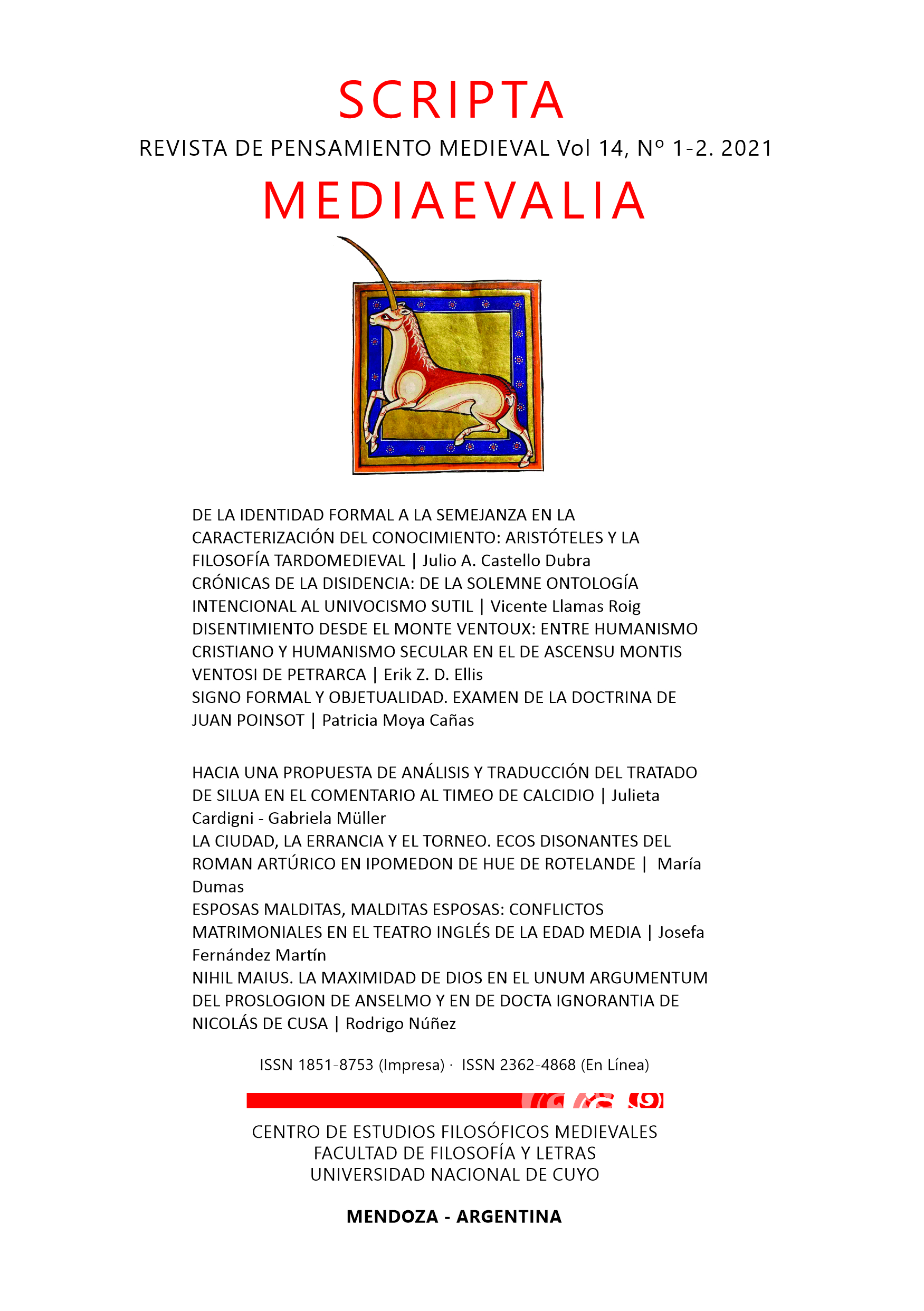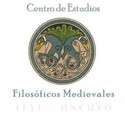Cities, Wanderings, and Tournaments. Dissonant Echoes of Arthurian Romance in Ipomedon by Hue de Rotelande
DOI:
https://doi.org/10.48162/rev.35.006Keywords:
Ipomedon, Hue de Rotelande, Anglo-Norman literature, Arthurian romance, medieval cityAbstract
Ipomedon, dated to 1180-1185, has been described by Penny Eley as an irritating text. This description proves to be highly fitting, due to the author’s inclination to use and, simultaneously, distort the narrative conventions of Arthurian romance established a few years earlier by Chrétien de Troyes. In this paper, Hue de Rotelande’s peculiar reception of the Arthurian narrative model will be analyzed with a focus on the role ascribed to the city throughout the story. It will be suggested that, in his work, Hue disrupts the different inside/outside dynamics traditionally established by the city in romances in order to drive the action and, thus, the story: errantry and tournaments. The rather defective working of these dynamics in Ipomedon will bring to light Hue’s playful rewriting of the genre of romance, in which the author, simultaneously, inscribes his story.
References
Bajtín, Mijaíl. Teoría y estética de la novela, traducido por Helena S. Kriúkova y Vicente Cazcarra. Madrid: Taurus, 1989.
Baker, John. The Tournament in England, 1100-1400. Woodbridge: The Boydell Press, 1986.
Bezzola, Reto. Le sens de l’aventure et de l'amour. París: Champion, 1968.
Calin, William. “The Exaltation and Undermining of Romance: Ipomedon”, en The Legacy of Chrétien de Troyes, editado por Norris J. Lacy, Douglas Kelly y Keith Busby, vol. 2, 111-124. Amsterdam: Rodopi, 1988.
Cartlidge, Neil. “Masters in the Art of Lying? The Literary Relationship between Hugh of Rhuddlan and Walter Map”. The Modern Language Review 106 (2011): 1-16.
Chênerie, Marie-Luce. Le chevalier errant dans les romans arthuriens en vers des XIIe et XIIIe siècles. Ginebra: Droz, 1986.
Chrétien de Troyes. Erec et Enide, editado por J.-M. Fritz. París: La Pochothèque, Le livre de Poche, 1994.
Chrétien de Troyes. Cligès, editado por Charles Méla y Olivier Collet. París: La Pochothèque, Le livre de Poche, 1994.
Chrétien de Troyes. Le Chevalier au Lion, editado por David Hult. París: La Pochothèque, Le livre de Poche, 1994.
Chrétien de Troyes. Le Chevalier de la Charrette, editado por Charles Méla. París: La Pochothèque, Le livre de Poche, 1994.
Chrétien de Troyes. Le Conte du Graal, editado por Charles Méla. París: La Pochothèque, Le livre de Poche, 1994.
Combes, Annie. Les voies de l’aventure. Réécriture et composition romanesque dans le Lancelot en prose. París: Champion, 2001.
Crane, Susan. Insular Romance. Politics, Faith and Culture in Anglo-Norman and Middle English Literature. Berkeley/Los Angeles: University of California Press, 1986.
Denis Piramus. La vie seint Edmund le rei, poème anglonormand du XIIème siècle, editado por Delbert W. Russell. Oxford: Anglo-Norman Text Society, 2014.
Eley, Penny. “The Subversion of Meaning in Hue de Rotelande’s Ipomedon”. Reading Medieval Studies 26 (2000): 97-112.
Fabliaux, editado por Felicia de Casas. Madrid: Cátedra, 2005.
Field, Rosalind. “‘Pur les francs homes amender’: Clerical Authors and the Thirteenth-Century Context of Historical Romance”, en Medieval Romance, Medieval Contexts, editado por Rhiannon Purdie, 175-188. Woodbridge: Boydell & Brewer, 2011.
Flori, Jean. Chevaliers et chevalerie au Moyen Age. París: Hachette Littératures, 1998.
Frow, John. Genre. Londres/Nueva York: Routledge, 2006.
Furrow, Melissa. Expectations of Romance. The Reception of a Genre in Medieval England. Woodbridge: Boydell & Brewer, 2009.
Gaunt, Simon. Gender and Genre in Medieval French Literature. Cambridge: Cambridge University Press, 1995.
Gouttebroze, Jean-Guy. “L’image de la ville dans l’œuvre romanesque de Chrétien de Troyes”. Razo 1 (1979): 38-46.
Guerreau-Jalabert, Anita. Index des motifs narratifs dans les romans arthuriens français en vers (XIIe -XIIe siècles). Ginebra: Droz, 1992.
Guillaume le Clerc. Fergus, editado por Wilson Frescoln. Philadelphia: William H. Allen, 1983.
Haidu, Peter. “Le sens historique du phénomène stylistique. La sémiose dissociative chez Chrétien de Troyes”. Revue Europe 60, no. 642 (1982): 36-47.
Hanning, Robert. “Engin in twelfth-century romance: an examination of the Roman d'Enéas and Hue de Rotelande’s Ipomedon”. Yale French Studies 51 (1974): 82-101.
Hue de Rotelande. Ipomedon editado por Anthony J. Holden. París: Klincksieck, 1979.
Hutcheon, Linda. “Ironie et parodie: stratégie et structure”. Poétique 9, no. 36 (1978): 467-477.
Krueger, Roberta. “Misogyny, Manipulation, and the Female Reader in Hue de Rotelande’s Ipomedon”, en Courtly Literature. Culture and Context. Selected papers from the 5th Triennial Congress of the International Courtly Literature Society, Dalfsen, The Netherlands, 9-16 August, 1986, editado por Keith Busby y Erik Kooper, 395-409. Amsterdam/Philadelphia: John Benjamins Publishing Company, 1990.
“Le Lay dou Lecheor”, en Chevalerie et grivoiserie. Fabliaux de chevalerie, editado por Jean-Luc Leclanche. París: Champion, 2003.
Lachet, Claude. “‘Mais où sont les tournois d’antan?’ La fin de joutes dans La Mort le Roi Artu”, en La mort du roi Arthur ou le crépuscule de la chevalerie, editado por Jean Dufournet, 134-155. París: Champion, 1994.
Lachet, Claude. “De la guerre à la Table ronde: variations sémantiques des locutions Cil dedans et Cil dehors”, en Mélanges Claude Lachet, editado por Corinne Pierreville y Philippe Bulinge, 173-187. Villeurbanne: APRIME Éditions, 2008.
Legge, M. Dominica. Anglo-Norman Literature and its Background. Westport: Greenwood Press, 1963.
Mora, Francine. “Remploi et sens du jeu dans quelques textes médio-latins et français des XIIe et XIIIe siècles” en Auctor et Auctoritas.
Invention et conformisme dans l'écriture médiévale. Actes du colloque tenu à l'Université de Versailles-Saint-Quentin-en-Yvelines (14-16 juin 1999), editado por Michel Zimmermann, 219-230. París: École des Chartes, 2001.
Nadot Sébastien. Le spectacle des joutes: sport et courtoisie à la fin du Moyen Âge. Rennes: Presses universitaires de Rennes, 2012.
Paris, Gaston. “Lais inédits”. Romania 8 (1879): 29-72.
Spensley, Ronald. “The structure of Hue de Rotelande’s Ipomedon”. Romania 95 (1974): 341-351.
Stanesco, Michel. “Le secret de l’estrange chevalier: notes sur la motivation contradictoire dans le roman médiéval”, en The Spirit of the Court: Selected Proceedings of the Fourth Congress of the International Courtly Literature Society, editado por Glyn S. Burgess y Robert A. Taylor, 339-349. Cambridge: Brewer, 1985.
Stanesco, Michel y Michel Zink, Histoire européenne du roman médiéval (París: PUF, 1992), Tally, Robert. Spatiality. Londres/Nueva York: Routledge, 2013.
Zumthor, Paul. Essai de poétique médiévale. París: Éditions du Seuil, 1972.
Zumthor, Paul. La Mesure du monde. París: Éditions du Seuil, 1993.
Downloads
Published
How to Cite
Issue
Section
License

This work is licensed under a Creative Commons Attribution-NonCommercial-ShareAlike 3.0 Unported License.






































